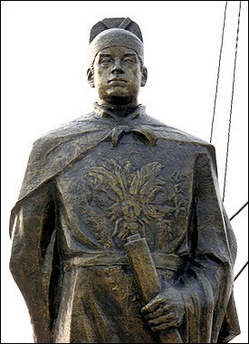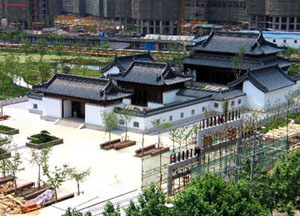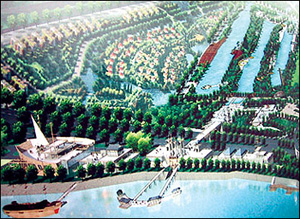Summary of Nanjing and the Treasure Fleets in Modern
China
In 1403, just one year into his reign, Emperor Yongle
sent out orders to begin construction of a massive fleet intended to re-establish
trade (and tribute) with neighbors of China.
While there have been claims that the first voyage was partially intended
to root out Zhu Yunwen, the nephew he deposed to
acquire the throne, his primary motive appears to have been much more diplomatic.
The very first order required Fujian province to produce 137
sea-worthy ships. Three months later a number of other provinces were ordered
to produce 200 more. Within the next three years, 1,681 ships were built or
altered to be used in the fleet.
The Longjiang shipyard in Nanjing became the center of production
for new ships. Situated on the Yangzi River,
Longjiang grew significantly during the twenty five
years of voyages. By 1433 and the last voyage, Longjiang
shipyard had seven 1,500 foot dry-docks and between twenty and thirty thousand
people working and living there.
 Admiral
Zheng He
Admiral
Zheng He
Today the Chinese government is proudly exhibiting the history of Longjiang shipyard and the Treasure Fleet. Zheng He¡¯s Treasure Fleet Ruins Park has opened last year
in Nanjing
during to celebrate the sixth hundred anniversary of the first voyage. The
park is built next to the ruins of the original Longjiang
shipyard. It features a reconstruction of a Ming style temple as its administrative
building, as well as a dry dock exhibiting the techniques used in constructing
the largest flag ships of the fleet. Another part of the park focuses on the
lives of the workers and their culture. And part on the actual voyages. Another
part of the celebration of this period has been the reconstruction of the
Tanfei Temple
that Zheng He had constructed in 1407 to honor the
Sea Goddess. The temple was destroyed in 1937 by Japanese artillery but was
rebuilt in 2005.
 Reconstructed Temple
Reconstructed Temple
 Longjiang Shipyard Ruins Park
Longjiang Shipyard Ruins Park
A road that parallels the Yangzi between the temples
and the shipyard, a path Zheng He surely traveled,
has been renamed in his honor. The interest in rediscovering one of the greatest
expeditions of all time is not only taking place in Nanjing.
A Taiwan-based group, called the Society of Extreme are recreating
the voyages of the Treasure Fleet in an expedition that will reach all the
known port-of-calls that the original voyages did. In Great Britain, Gavin Menzies continues to lecture on his claims that the Treasure
Fleet reached the Americas
and circumnavigated the globe.
Menzies also says that he has located wrecks from
the fleet and is working to document his discovery before revealing the site.
Chinese governmental officials have hoped to use the peaceful nature of the
Treasure Fleet, despite their undisputed superiority, as a sign that China¡¯s rise in global status
will be similarly affable and nonviolent. For others, the voyages are yet
another reminder of China¡¯s history of ethnocentricity
and unwillingness to take part in a global system. Considering the fact that
a conflict over power between eunuchs and officials once destroyed the most
important records of the voyages and pushed both Zheng He and his endeavors into relative darkness, a return
to the light of Chinese History is an accomplishment in itself.
 Admiral
Zheng He
Admiral
Zheng He Reconstructed Temple
Reconstructed Temple Longjiang Shipyard Ruins Park
Longjiang Shipyard Ruins Park